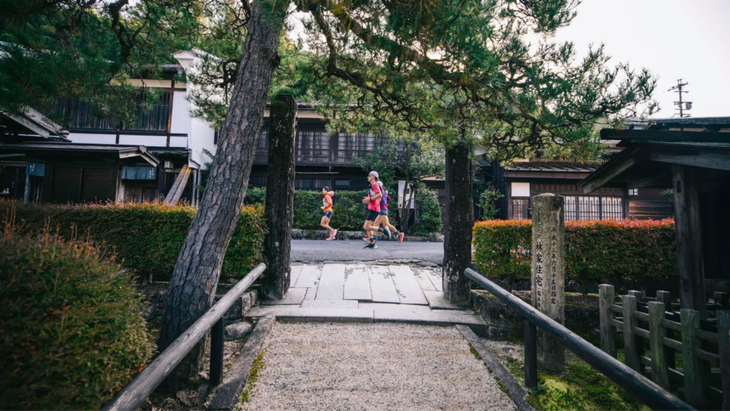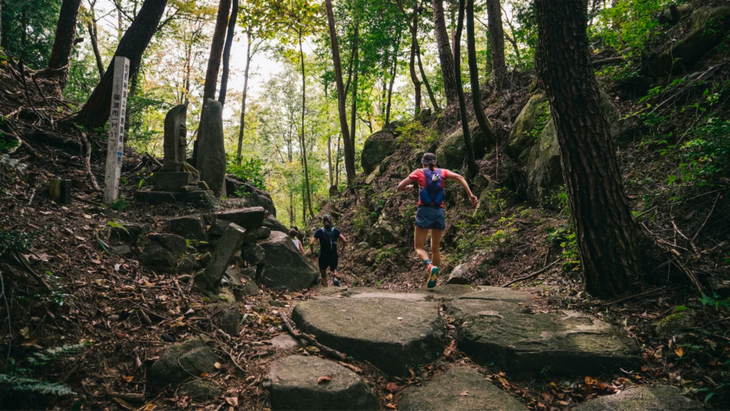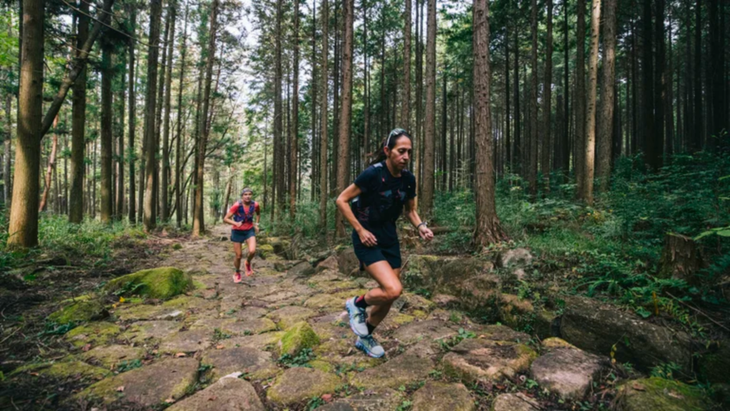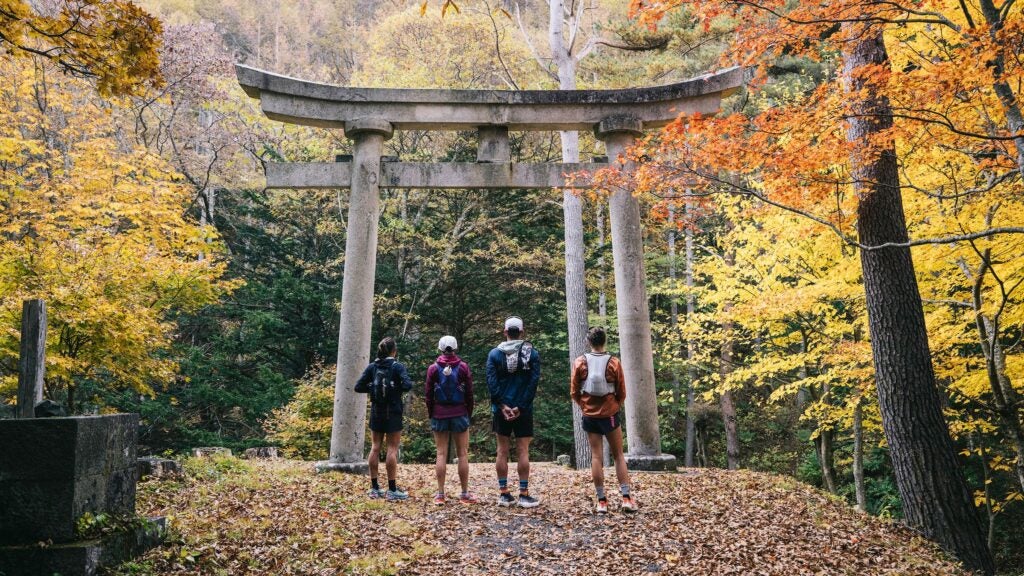No products in the cart.
Outdoor Adventure
Running the Nakasendo, an Ancient Postal Route Across the Japanese Alps
Unlike the Kumano Kodo, Japan’s famous pilgrimage route and one of just two roads on the planet designated as a UNESCO World Heritage site, the Nakasendo is rarely known outside of the country.
Built at the start of the Edo period in the early 1600s, it connected the empire through its mountainous interior. The Nakasendo thrived for two and a half centuries, propelling trade along its cobbled path, before it was lost to history.
In its heyday, the Naksendo was 330 miles long and connected Kyoto to Edo (present day Tokyo), cutting southwest to northeast right in the center of the country. Along it were 69 post towns, each five or so miles apart, for travelers to stop, eat, and exchange goods. While the majority of the path is now covered by pavement, some stretches and original towns are well preserved, with wood buildings and traditional interiors, allowing visitors to travel 400 years back in time.
Wanting to do just that, I brought together a group of friends and professional runners, including a pair of U.S. Olympains Des Linden and Magda Boulet, and two accomplished 100-milers, Tim Tollefson and Ruth Croft, to run the most iconic stretch, from Nagoya to Matsumoto. This was a dream group that meshed easily because everyone felt a heightened passion for using running as a tool to explore a new place and new culture. Each day we would run about 20 miles, stopping at post towns, temples, and ramen shops, and each night we’d stay at an inn or onsen, soaking in natural hot springs to recover and prepare for the day ahead.

Route and Onsens
There are distinct pros and cons to building a route around a trail that was built 400 years ago. The Nakasendo lends itself to the type of runner that wants to get more out of the experience than just putting one foot in front of the other. It has a deep history and rich folklore, good food and traditional inns, and sections that are remote and beautiful. These sections whisk you back in time to the Edo period, experiencing what it was like to travel on foot along the ancient postal route.
However, if you’re just looking for the absolute best trail running in Japan, the Nakasendo should be fairly low on your list. It’s a jumbled mix of trails, rural roads, streets, and highways, without a ton of continuity thanks to new development. Expect a good amount of road running to get to the iconic trail sections and a lack of fluidity on some days. That said, after a hundred miles of the trail, I still think it’s totally worth it.
RELATED: Ecuador’s Cotopaxi Route Might Be The Best Hut-to-Hut Experience in the Americas
Our route passed through four well preserved post towns, Tsumago, Magome, Fukushima, and Narai, near dozens of temples and shrines, with ample opportunities to stay at traditional inns and onsens along the way. This was a huge highlight that allowed us to tap into Japanese culture, while recovering for more miles the next day. Sometimes we would even get up early in the morning to soak again.

To average 20-plus miles each day, we used the support of a luggage transfer service to move our bags to the next accommodation. This allowed us to run just water, snacks, and spare layers, making the experience much more enjoyable. If you consider following this route, I would highly consider this option.
Navigation on the route itself is a mixed bag—some of it is marked well, while other parts are almost non-existent. I would recommend downloading GPX files and being comfortable with a navigation app like Gaia before you head out on the Nakasendo.
Flights and Trains
Following the worst of the pandemic in November 2022, Japan re-opened their borders to foreigners and Japan has become easy to travel to. Our group rendezvoused at the Haneda airport, then spent a day in the city to explore the famous fish market, eat ramen, and recover from the jet lag. While we could have stayed longer, we decided to maximize our time on the Nakasendo.
From Tokyo, it is easy and affordable to take high speed trains to other cities around the country, including our start and end points. The ride to Nagoya took a couple hours and the return trip from Matsumoto was about the same. If I were to run the Nakasendo again, I wouldn’t change any of our logistics. The trains saved us the cost of a rental car, learning to drive on the left side, and the hassle of shuttling it daily.

Weather and Wildlife
We visited Japan in the fall, hoping for cool running temps, fewer tourists, and autumn colors. This decision paid dividends, with most days ranging from low 40s to the high 60s, ample availability at many inns and onsens, and vibrant leaf colors, especially in the high country.
We started our run near sea level and topped out in the mountains around 4,000 feet. While fall often brings unpredictable weather to the Japanese Alps, that was not the case during our trip.
We’d been advised to pack a raincoat for the high likelihood of storms, but ended up never using them. With nearly perfect running conditions for the duration of the trip, we were able to slow down and savor the tea houses, temples, and ramen stops along the way. Also, while there were quite a few warning signs for bears, and we saw many hikers with bear bells, we didn’t spot any ourselves and were later told by a local guide that they no longer exist so far south in the Japanese Alps.

Permits and Fees
Running the Nakasendo takes a good amount of planning—which is tricky if you’re not fluent in Japanese—but does not require any permits or entry fees. Outside of the major cities in Japan, English isn’t super common even at restaurants and stores, so be prepared to use tools like Google Translate to get by. Much of the Nakasendo is through the rolling countryside, where you’ll meet more locals than other hikers or runners, but again, it can be hard to interact with many of them. A few of the post towns are very popular tourist destinations, but long stretches of the Nakasendo feel almost forgotten in time.
RELATED: 8 Essential Tips for Trail-Running Travel
Gear That Worked
Nike Ultrafly Trail Shoes: Wanting to pack as light as possible, I opted for one pair of travel-around-town shoes and one pair of running shoes. Therefore, I needed something that would be versatile, durable, and comfortable for big days. The Ultrafly—yes, the new carbon-plated race-oriented shoe—proved it could be a do-it-all travel shoe, providing enough grip on the trail sections without making long stretches of pavement miserable. No blisters, no falls. I’ll take it.
GU Stroopwafels: Not knowing when and where we’d stop for lunch every day, I packed a healthy amount of snacks in my running back. While I generally prefer savory things like chips, on this trip I found myself gluttonously feasting on stroopwafels, a Dutch-style treat that acts like a gel but tastes like breakfast.

Patagonia Slope Runner Vest: As someone who regularly runs with a full-frame camera, large first aid kit, spare layers, InReach, and hordes of snacks, I tend to opt for larger-volume packs. That said, I also try to find packs that don’t feel like a shifty monkey on my back. My go-to is the Slope Runner, which can carry up to 18 liters and be cinched down snug and secure on your back.
Theragun Mini: While it’s not light enough to bring on a true backcountry trip, the Theragun Mini is the perfect tool for travel trips like this one. To be clear, we didn’t carry it during the day, but did enjoy having it at night to speed up recovery, reduce soreness, and make sure my quads didn’t completely fall off trying to keep up with this group of superhuman runners.
Source link

